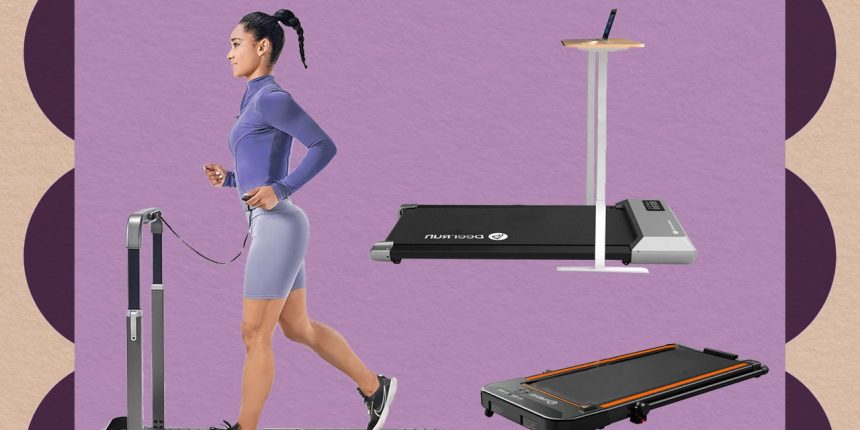Just so you know: The treadmill is powered by a 2.5 horsepower motor that can support speeds up to 7.6 miles per hour, and it also has a foldable handlebar. Still, we wouldn’t suggest this one for runners who are taller than 5 foot 9—and have the stride length to show for it. Our tester of that height nearly fell off the machine after attempting to break into a run.
Dimensions: 53.1”L x 26.4”W x 4.7”H | Tread belt: 40”L x 17”W | Weight capacity: 265 lbs | Max speed: 7.6 mph | Incline: None | Motor: 2.5 HP | Display: Small LED display | Warranty: 1 year | Folding options: Handle folds down | Membership: None
Best Under Desk Treadmill Under $500: DeerRun Q1 Plus
DeerRun Q1 Plus
Pros
- Affordable option
- Extremely light at just 41 pounds
Cons
- Has a 265-lb weight capacity (better than others on this list but still not amazing)
- Can’t be used for running
- Very short deck might not be ideal for longer strides
Why we picked it: It’s tough to find a treadmill under $300 that’s actually worth considering, but the DeerRun Q1 Plus has some of the same features as pricier models, like an LED panel that displays your workout time, speed, and distance, and syncing capabilities with Apple Health and an accompanying app. The treadmill has gone over well with Amazon reviewers, who report that it’s easy to set up and use. “Setting it up was super straightforward and I like the convenience of the app to track my workouts,” one reviewer wrote. “It’s also quiet enough that it doesn’t bother my roommates when I use it or be heard on calls.”
Who it’s for: The DeerRun Q1 Plus is best for budget-conscious people who don’t plan on running, since the treadmill reaches 3.8 miles per hour. (It also has a pretty short deck, so it’s likely better for people with shorter steps.)
Just so you know: You might not be happy with the DeerRun Q1 Plus (or any $249 treadmill for that matter) if you want the shock absorption of a cushioned treadmill. One reviewer noted that the treadmill felt hard on their knees compared to other machines they’ve tried.
Dimensions: 45”L x 20”W x 4.5”H | Tread belt: 35.5”L x 15.5”W | Weight capacity: 265 lbs | Max speed: 3.8 mph | Incline: None | Motor: 2.5 hp | Display: Small LED display | Warranty: 2 years | Folding options: None | Membership: None
Benefits and drawbacks of an under desk treadmill
Whether you opt for an under desk treadmill, a regular treadmill, or a sidewalk, a daily stroll can benefit your health. “There’s no denying the benefits of walking and daily movement,” says Melissa Kendter, ACE-certified personal trainer and UESCA-certified running coach. Walking daily can support heart health, mental health, and help protect your joints, she says. Under desk treadmills allow you to incorporate more walking into your day by multitasking. They also tend to be more affordable and compact (read: space-saving) than full-size options.
But before you kick yourself for not already owning one, know that the benefits of under desk treadmills come with some caveats. They typically have a lower top speed than traditional treadmills, says Dr. Mercer, so don’t expect to train for a marathon using one. Your walking form may also become altered while using an under desk treadmill. For example, if you’re using a computer mouse while walking on a treadmill, you won’t be swinging your arms as you would naturally, and Dr. Mercer says this can be uncomfortable.
How to find the best under desk treadmill for you
Under desk treadmills aren’t all the same. Here are the elements that can help you decide which option will work best for you.
Price
Budget can definitely play a part in your decision. Our top under desk treadmill picks range in retail price from $299 to $999 (before sales, which are common), so clearly, the cost can really vary. (Meanwhile, the traditional models on our best treadmills list range from $999 to $3,499.) “An under desk treadmill should be considerably cheaper than most traditional treadmills due to certain limitations, such as the motor’s power,” says Rodgers. “However, while you may be tempted to go for the cheapest option, consider durability and performance, as you want your treadmill to last with regular use and suit your requirements.”
Size and portability
Under desk treadmills are categorically compact (since, you know, they have to fit under a desk), but some are more so than others. “Size is primarily the reason you will choose an under-desk treadmill in most cases, so ensure it fits your space effectively while still being practical for you to use,” Rodgers says. “Consider the width and length, as well as any weight limitations, to ensure it fits you and your stride properly. Also, remember that when you start walking faster or jogging, you will likely take longer strides, so it’s important to have plenty of room on the treadmill surface.”
Warranty and trial period
A long warranty can provide you with peace of mind, and it’s an indication that a company stands by its product, Rodgers says. (Most products on our list have a warranty of at least 1 year.)
Ease of use
You can also factor in whether the treadmill requires assembly out of the box and whether it’s complicated to get going. “Under desk treadmills are generally easy to use because they have fewer options for settings and entertainment. Some are as simple as plug in and switch on,” says Rodgers. “However, certain under desk treadmills may offer phone app connectivity to track your steps and distance or music capabilities, which may require a bit more effort to get up and running.”
How we tested these treadmills
SELF’s team of testers has tried tons of treadmills, paying close attention to the qualities that separate the best from the rest. You can check out our full fitness-testing methodology here, but in the meantime, here’s a sample of what we focus on when testing treadmills:
If you’re in the market for an under desk treadmill rather than a full-size machine, there’s a good chance you’d like to be able to move it around to store it. To rate a treadmill’s portability, testers consider its weight, whether it has sturdy wheels, and how easy it is to maneuver on different types of flooring.
Because under desk treadmills are designed for walking, they don’t need to be heavy duty to get the job done. But, you still want stability with your steps (particularly on models without handrails). Testers take notice of whether a tread wobbles under their feet and how well it handles different body sizes and heights.
Some under desk treadmills aren’t designed for running, and can’t reach high speeds; testers consider a treadmill’s maximum speed as well as how easy it is to adjust the speed before rating this category.
Testers evaluate a treadmill’s dimensions by taking into account whether it can be folded up—and if so, how easily.
FAQs
Here are answers to common questions about under desk treadmills.
What is an under-the-desk treadmill?
Under desk treadmills are small treadmills that can be used under a standing desk. “They are essentially walking pads with no bells and whistles, are easy to use, simple to walk on for periods of time, light enough to move around, and cost-friendly,” says Kendter.
How effective is an under desk treadmill?
Under desk treadmills can effectively allow you to reap the benefits of walking. “You shouldn’t expect to get the same mileage and versatility as [you would with] a traditional treadmill, but they do their job well and cost a lot less,” says Kendter. “For someone who wants to incorporate walking throughout their day in an easy manner, then they are a great option.”
Are under desk treadmills worth it?
An under desk treadmill can be worth shelling out for, particularly if your desk job prevents you from walking as much as you’d like. “Finding ways to be active in our regular daily lives is important,“ Dr. Mercer says. “Under desk treadmills are a way to try to increase activity levels for [some people] who may be sitting for long periods of time.”
What are the cons of using an under desk treadmill?
Some of the drawbacks of under desk treadmills include that, compared to full-sized models, their belts are typically smaller (which can make them tough for people with longer strides to use), incline and decline settings aren’t as wide, and they don’t have large touchscreens, according to Kendter.
Related:







